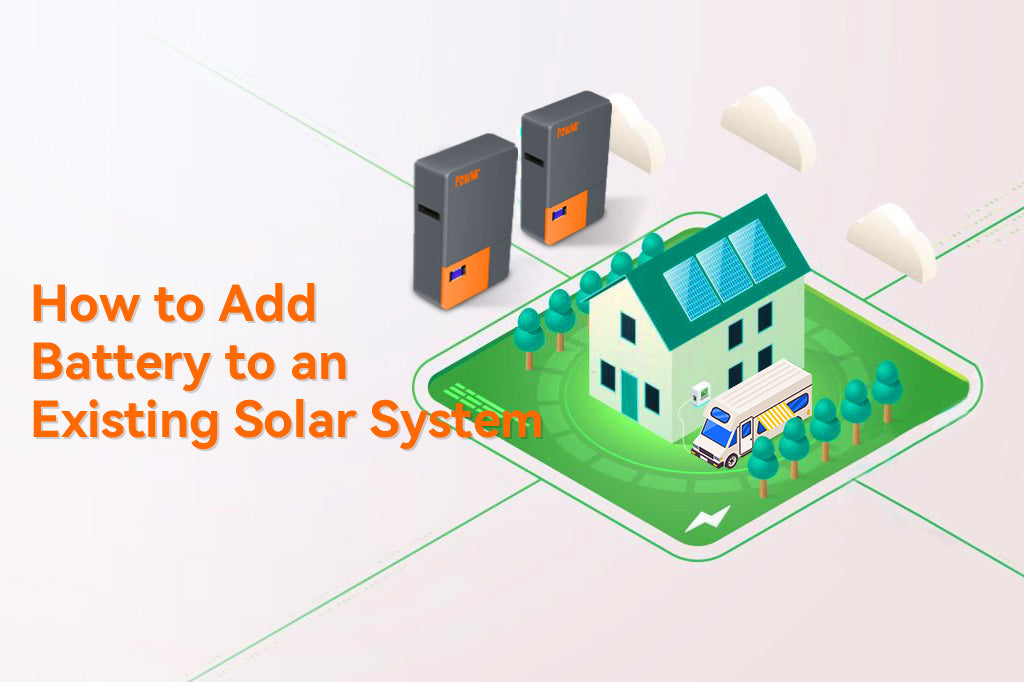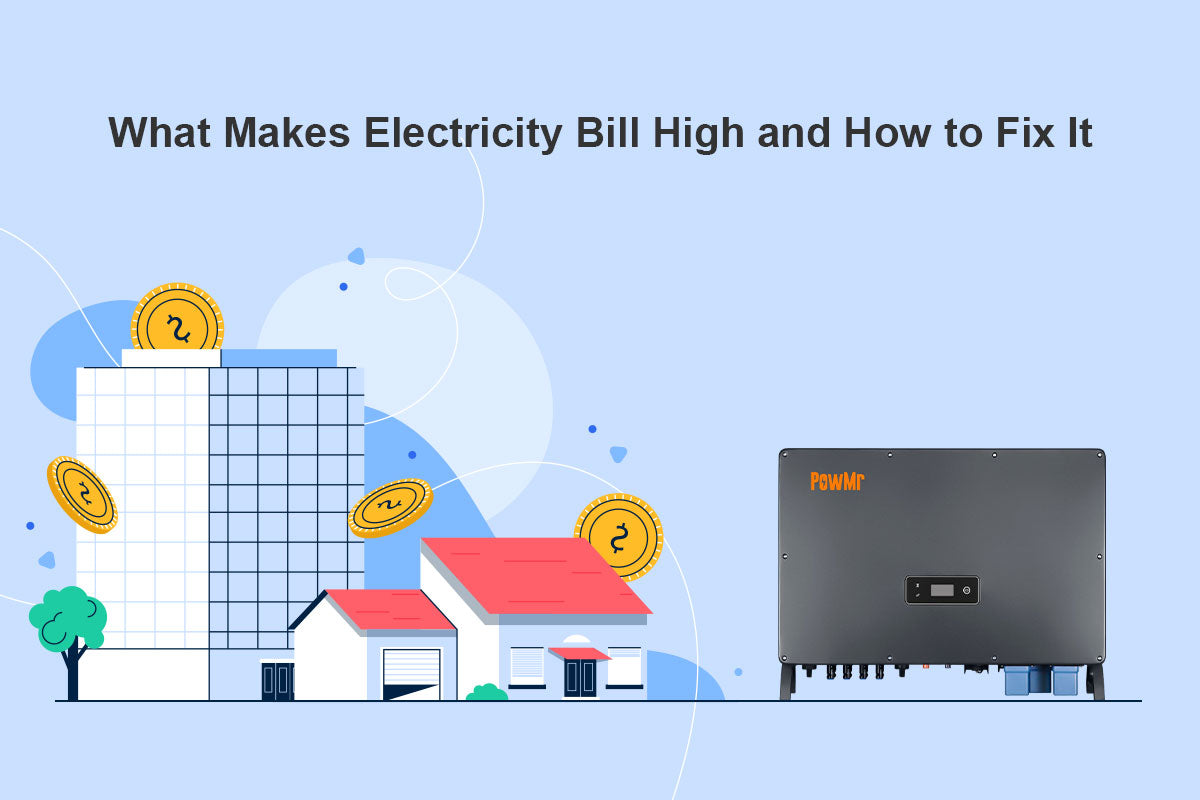"The Global Residential Solar Energy Storage Market is predicted to attain USD 88.94 billion by the end of 2028, up from USD 15.24 billion in 2022, with a current CAGR of 34.85% throughout the foreseen period 2023-2028," as stated by marketdataforecast.
This surge is driven by the rising adoption of battery storage solutions in solar systems. Homeowners are increasingly considering incorporating batteries to enhance energy resilience and efficiency.
In this article, we explore the process of adding batteries to various solar setups, from off-grid and RV systems to grid-tied setups.
Can I Add Battery to My Solar System?
Before delving into the details of adding batteries to various solar systems, it's essential to address the question on many homeowners' minds: Can I add a battery to my solar system? The answer is yes, in most cases. Whether you have an existing off-grid, grid-tied, or RV solar system, adding battery storage is possible and can significantly improve energy resilience.
How to Add Extra Battery to Grid-Tie Solar System
Why add a battery to solar system
You might consider adding batteries to grid-tie systems for the following reasons:
Energy Independence
Enhance grid independence, particularly in areas with frequent outages or where
reducing
grid reliance is desired.
Time-of-Use Savings
Lower electricity costs by storing
excess solar energy during low-rate periods and
utilizing it during peak-rate periods, which is prevalent in regions with time-of-use pricing.
Net Metering Optimization
Maximize net metering benefits by storing surplus solar energy and feeding
it back to
the grid during peak demand times.
Emergency Preparedness
Ensure critical appliances continue to function during emergencies, providing
security
and preparedness.
No matter the reason, you can choose between three main methods for incorporating batteries in grid-tie system: AC coupling, DC coupling and replace a storage-ready solar inverter.
AC Coupling
AC coupling refer to the process of getting the solar array DC power to storage in the the DC battery via through the AC switchboard, pairing the grid tie inverter and an extra off grid inverter charger to charge the battery.
DC Coupling
DC coupling bypasses the need for an AC bus, allowing solar DC power to directly charge the battery. Typically, to manage the power flow from the solar panels to the battery, an additional charge controller is required. The panels connect directly to the charge controller in DC, which then facilitates charging the battery.
However, both DC coupling and AC coupling methods have their drawbacks. For instance, there may be communication issues between the inverter charger/charge controller, energy meter and the existing solar inverter. These issues arise when determining the optimal times for charging and discharging based on surplus solar energy.
So, if your current inverter is approching the end of life, we recommond you to replace a grid tie hybrid inverter, another DC coupling solution.
Replace a storage-ready solar inverter
The Grid Tie Hybrid Inverter integrates ports for PV, battery, and grid connectivity, facilitating comprehensive control over the entire energy system. Despite potential higher initial costs, it effectively manages electricity distribution between the grid, battery storage, and loads, optimizing cost savings across different tariff plans.
SOLXPOW is an advanced grid tie inverter designed to enhance convenience and efficiency in energy management. Equipped with smart metering and 24-hour load monitoring capabilities, it enables seamless remote control via cloud access from both PC and mobile devices. Its configurable features ensure adaptability to various tariff policies and optimize energy consumption:
- Grid consumption threshold management
- Peak shaving mode
- Three-phase unbalanced output support
- Remote monitoring and control
- UPS mode within 10 milliseconds
- Grid export power limitation
How to Add Battery to Off-Grid Solar System
Adding extra batteries has become one of the critical aspects of enhancing the efficiency and reliability of off-grid solar systems.
In this part, we will explore two scenarios: adding extra batteries for a home solar system and integrating batteries into a DC to DC solar system for an RV. We will discuss the reasons behind choosing each option and provide step-by-step installation guides for both scenarios.
Add Extra Battery for Home Solar System
Here are the situations in which adding batteries to an off-grid system can prove highly advantageous.
Expand Energy Storage Capacity
Add more batteries to your solar system for increased energy storage. This stores excess solar
energy for later use during low production or at night. As solar panels expand, battery storage becomes
crucial for a reliable power supply.
Power Backup
In regions prone to power outages or areas with
intermittent grid connectivity, adding batteries
to your solar system allows you to store excess energy, ensuring preparedness for unpredictable climate changes
and emergencies.
Steps to Add Battery to Home Solar System:
Step1. Assess Energy Needs
Determine the energy requirements of your household. This will help
you estimate the number of batteries
needed to store sufficient energy to meet your needs during low-sunlight
periods.
Step2. Choose Solar
Batteries Types
Ensure that the new batteries match the specifications of
the
existing battery bank. This includes parameters such as battery capacity, voltage, and chemistry.
Consistency in charging and discharging prevents uneven wear and extends the battery's lifespan. Moreover, uniform batteries enhance system efficiency and simplify maintenance and monitoring. Diverse batteries can lead to imbalances, potential hazards like overheating, explosions, or fires, and overall system inefficiency.
Selecting matched batteries creates a reliable, efficient, and safe solar setup, reducing costs and risks.
Step3. Connect Batteries in Parallel
Properly connecting the batteries in
parallel
to increase
the energy storage capacity. Parallel connections involve connecting the positive terminals of all
the batteries
together
and connecting the negative terminals together
. This configuration ensures that the voltage remains the
same while the overall capacity increases.
Note:
Depending on your system's voltage and battery configuration, you may connect the new batteries in series or parallel.
Series connection increases the system voltage, while parallel connection increases the capacity. The key is to ensure that the specifications and rated voltage range of the controller cover the new battery system.
To maximize the benefits of adding batteries to your solar system, consider using a dual battery charging controller. This advanced controller is designed to efficiently manage two batteries independently, avoiding the potential imbalances and hazards that might arise from connecting different types of batteries in series or parallel.
If you lack experience in electrical work or are unsure about connecting the controllers, it is essential to seek assistance from a professional to prevent electrical issues and ensure safety.
Step4. Choose and Install Charge Controller
Select an appropriate charge controller to
regulate the charging and discharging of the batteries. The charge controller protects the batteries from
overcharging and ensures efficient energy transfer between the solar panels and batteries.
Consider factors like panel capacity and battery voltage/chemistry. Opt for features like Maximum Power Point Tracking (MPPT) for better performance. Follow manufacturer's instructions for installation, connecting panels and batteries safely.
Add Battery to DC to DC Solar System for RV
In an RV, a DC to DC solar system can be an excellent way to harness solar energy and use it efficiently for various electrical needs.
By adding a battery to this setup, you can further enhance its capabilities and enjoy more reliable power on your travels. Here are the situations where adding a battery to an RV solar system can be beneficial:
Extended Off-Grid Travel
If you plan to spend extended periods off-grid, adding
a battery to your
RV solar system allows you to store excess solar energy during the day and use it at night or when sunlight is
limited.
Enhanced Power for Appliances
Adding a battery to your RV solar system enables you to
power more
appliances and devices, even during periods of low sunlight. This can be particularly useful when you
have
energy-intensive equipment, such as a refrigerator, air conditioner, or other electronics that require continuous
power.
Redundancy and Backup
Having a battery in your RV solar system serves as a backup power
source in
case of unexpected weather changes or equipment malfunctions. It provides an additional layer of reliability and
ensures you won't be left without power in critical situations.
Steps to Add Battery to DC to DC Solar System for RV:
Step1. Determine Battery Capacity
Assess your energy needs and
determine how much additional
energy storage capacity you require. Consider the total energy consumption of your RV appliances and electronics,
the number of days you plan to spend off-grid, and the average energy production of your existing solar panels.
Step2.Choose the Right Battery
Select batteries that are compatible with your existing RV
solar
system. Ensure they have similar specifications in terms of voltage, chemistry, and capacity to
maintain a balanced
and efficient setup. Lithium-ion batteries are a
popular choice for RVs due to their lightweight, high energy
density, and longer lifespan compared
to traditional lead-acid batteries.
Step3.Connect the Battery and Solar Charge Controller
Install a battery charge controller between
the solar panels and the battery bank to regulate the charging process. Join battery (+) to controller (+) and (-)
to (-). Mount controller inside RV. Connect solar panels to controller. Verify connections. Turn on the system.
Monitor regularly.
Step4.Connect the Battery in Parallel
Similar to the home solar system, connect the batteries
in
parallel by joining the positive terminals together and the negative terminals together. This
configuration ensures
that the voltage remains consistent while the overall energy storage capacity increases.
You have the option to connect the new batteries either in series or in parallel, depending on your system's voltage and battery setup.
Step5.Consider a Battery Isolator
To prevent your RV's starter battery from
draining while using
the auxiliary batteries, consider installing a battery isolator or charge controller that separates
the two systems
when the engine is off. This ensures that your RV's primary battery remains charged and ready to start the engine.
Superior Alternative:
To resolve the issue of RV's starter battery draining while using the auxiliary batteries, consider using the PowMr DC to DC MPPT Solar Charge Controller. This versatile controller, with smart detection and Buck-Boost circuit design, providing the following benefits:
- Supports a dual battery system with two output ports
- Customizable charging priority of the Starter Battery and Service Battery with configurable voltage value setting
- Enables charging between Starter Battery and Service Battery based on BVS battery voltage detection
- Utilizes energy from alternator and solar panels to keep the RV fully charged
- Extends off-grid adventures with efficient energy management




Leave a comment
This site is protected by reCAPTCHA and the Google Privacy Policy and Terms of Service apply.